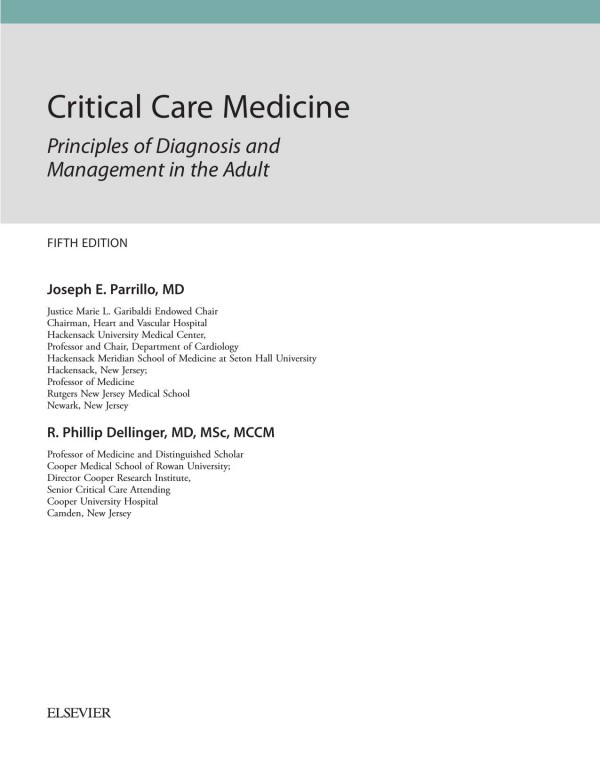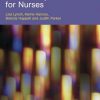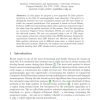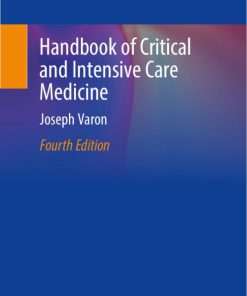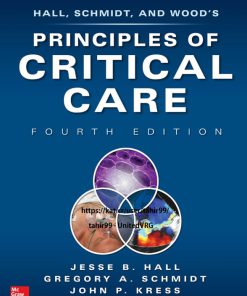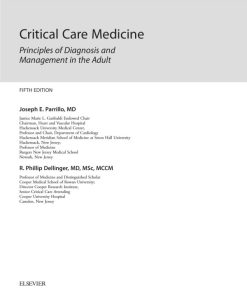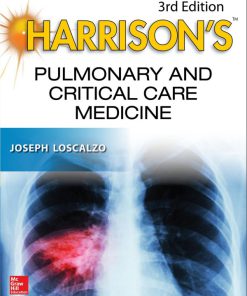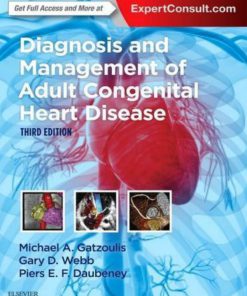Critical Care Medicine Principles of Diagnosis and Management in the Adult 4th Edition by Joseph Parrillo, Phillip Dellinger ISBN 0323089291 978-0323089296
$50.00 Original price was: $50.00.$25.00Current price is: $25.00.
Authors:Joseph E. Parrillo, R. Phillip Dellinger , Series:Medicine [126] , Author sort:Joseph E. Parrillo, R. Phillip Dellinger , Languages:Languages:eng , Published:Published:Feb 2019 , Publisher:Elsevier
Critical Care Medicine Principles of Diagnosis & Management in the Adult 4th Edition by Joseph Parrillo, Phillip Dellinger – Ebook PDF Instant Download/Delivery. 0323089291 978-0323089296
Full download Critical Care Medicine Principles of Diagnosis & Management in the Adult 4th Edition after payment
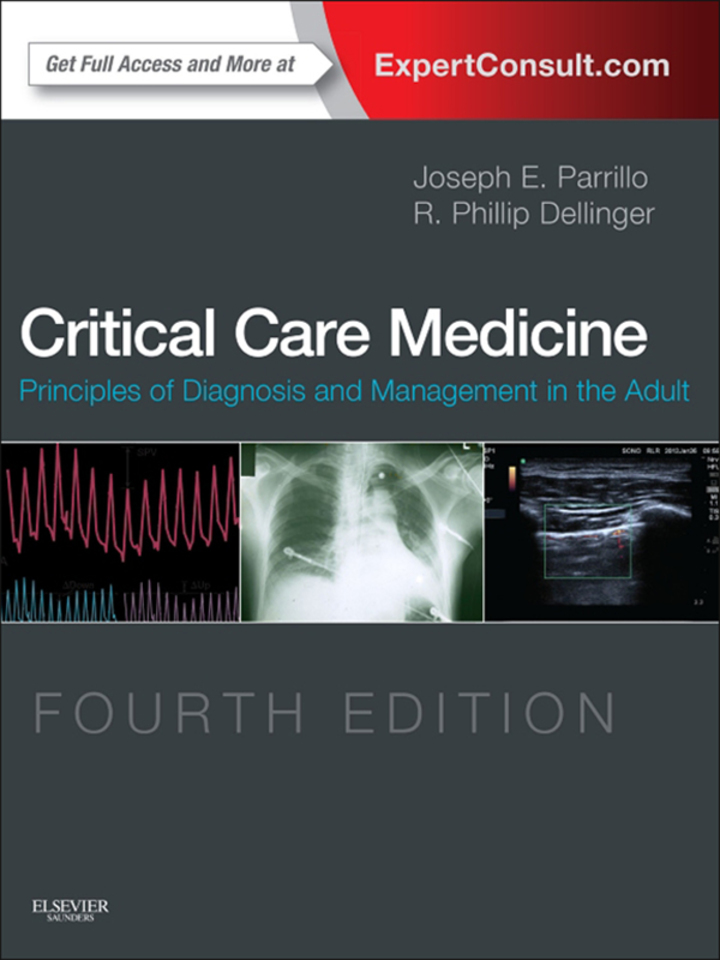
Product details:
ISBN 10: 0323089291
ISBN 13: 978-0323089296
Author: Joseph Parrillo, Phillip Dellinger
Take the best possible care of adult critical care patients with Critical Care Medicine: Principles of Diagnosis and Management in the Adult! Editors Dr. Joseph Parrillo and Dr. Phillip Dellinger, two of the most respected names in critical care medicine, combine their extensive knowledge with that of hundreds of top authorities in the field to bring you expert, state-of-the-art answers to any clinical question you may face in the intensive care unit.
- Offer your adult critical care patients the most effective care with practical, evidence-based guidance from many of the most trusted experts in critical care medicine.
- Learn from the best ICU specialists worldwide with contributions from an increased number of international authorities.
- Effectively manage common complications in the ICU with updated coverage of severe sepsis, septic shock, surgical infections, neurogenic and anaphylactic shock, severe heart failure, acute coronary syndromes, and Acute Respiratory Distress Syndrome.
- Access the complete contents online at Expert Consult, along with an image bank and instructional videos!
Critical Care Medicine Principles of Diagnosis & Management in the Adult 4th Table of contents:
Part 1: Critical Care Procedures, Monitoring, and Pharmacology
Chapter 1: Cardiac Arrest and Cardiopulmonary Resuscitation
Epidemiology and General Principles
Cardiopulmonary Resuscitation and Advanced Cardiac Life Support
Postresuscitation Care
Chapter 2: Airway Management in the Critically Ill Adult
Structure and Function of the Normal Airway
Assessing Adequacy of the Airway
Management of the Airway
Physiologic Sequelae and Complications of Tracheal Intubation
The Difficult Airway
Confirming Tube Position in the Trachea
Surgical Airway
Extubation in the Difficult Airway Patient (Decannulation)
Tube Displacement in the Critical Care Unit
The NAP4 Project
Common Problems in Airway Management
Chapter 3: Assessment of Cardiac Filling and Blood Flow
Cardiac Filling
Hemodynamic Status and Blood Flow
Goal-Directed Therapy
Conclusions
Chapter 4: Arterial, Central Venous, and Pulmonary Artery Catheters
Arterial Catheters
Central Venous Catheters
Pulmonary Artery Catheters
Chapter 5: Cardiac Pacing
Indications for Permanent Pacemaker Implantation
Indications for Temporary Pacing
Conditions That Do Not Normally Require Pacing
Esophageal and Transthoracic Pacing
Transcutaneous Pacing
Epicardial Pacing
Transvenous Pacing
Special Considerations in Temporary Pacing
Complications of Permanent Pacemaker Implantation
Special Considerations in Permanent Pacing
Conclusions
Chapter 6: Pericardial Tamponade: Clinical Presentation, Diagnosis, and Catheter-Based Therapies
Etiology of Pericardial Effusion and Tamponade
Clinical Presentation
Diagnostic Role of Echocardiography
Catheter-Based Diagnostic and Therapeutic Strategies
Pericardiocentesis
Open Surgical Pericardial Window
Percutaneous Balloon Pericardiotomy
Other Pericardial Interventions
Chapter 7: Intra-aortic Balloon Counterpulsation
History
Physiology
The Intra-Aortic Balloon Pump Apparatus
Preparation
Balloon Insertion
Timing
Adjunctive Pharmacotherapy
Balloon Removal
Indications
Contraindications
Complications
Newer Technologies
Chapter 8: Echocardiography
Approach to Echocardiography
Additional Echocardiographic Modalities
Indications for Echocardiography
Hemodynamic Assessment
Stroke and Other Systemic Emboli
Summary
Chapter 9: General Principles of Mechanical Ventilation
History
Mechanical Ventilation
Indications for Mechanical Ventilation
Mechanical Breath Generation
Ventilator Modes
Other Modes of Mechanical Ventilation
Positive End-Expiratory Pressure
Monitoring the Ventilated Patient
Maintaining Support of the Ventilated Patient
Weaning From Mechanical Ventilation
Complications of Mechanical Ventilation
Noninvasive Positive-Pressure Ventilation
Chapter 10: Ventilatory Management of Obstructive Airway Disease
Special Challenges of Patients with Severe Airflow Obstruction
Problems and Hazards of Ventilation with Positive Pressure
Principles of Managing the Ventilated Patient with Severe Airflow Obstruction
Practical Management of the Ventilated Patient
Chapter 11: Mechanical Ventilation in Acute Respiratory Distress Syndrome
History
Physiologic Basis of Mechanical Ventilation
Patient Characterization
Mechanical Ventilation in Acute Respiratory Distress Syndrome: Available Evidence
Individualizing Mechanical Ventilation in Patients with Acute Respiratory Distress Syndrome
Possible Adjuncts to Mechanical Ventilation
Chapter 12: Bronchoscopy and Lung Biopsy in Critically Ill Patients
Fiberoptic Bronchoscopy–Induced Physiologic Changes
Airway Evaluation and Management
Diagnosis of Infection
Lung Biopsy—Surgical and Transbronchial
Special Situations
Complications and Death
Summary
Chapter 13: Noninvasive Respiratory Monitoring
Gas Exchange
Respiratory Neuromuscular Function
Respiratory Mechanics
Chapter 14: Tracheostomy
History
The Artificial Airway
Timing of Tracheostomy
Complications of Tracheostomy
Percutaneous Tracheostomy
Chapter 15: Chest Tube Thoracostomy
History
Anatomy and Physiology of the Pleural Space
Drainage Systems
Indications and Contraindications
Chest Tube Size
Technique of Insertion
Management of Thoracostomy Tubes
Complications
Imaging
Chapter 16: Intracranial Monitoring
Intracranial Pressure Monitoring
Cerebral Blood Flow Monitoring
Brain Tissue Oxygenation Monitoring
Summary
Chapter 17: Gastrointestinal Endoscopy
History
Endoscopic Equipment
Anesthesia
Esophagogastroduodenoscopy
Wireless Capsule Endoscopy
Enteroscopy
Colonoscopy
Endoscopic Retrograde Cholangiopancreatography
Endoscopic Ultrasound
Endoscopy in the Pregnant Patient
Chapter 18: Continuous Renal Replacement Therapy
Physiologic Principles
Modalities
Prescription Variables
Technical Considerations
Therapeutic Considerations
Summary
Chapter 19: Use of Sedatives, Analgesics, and Neuromuscular Blockers
PAIN Management in the Intensive Care Unit
Sedation Management
Neuromuscular Blocking Agents
Summary and Conclusions
Chapter 20: Principles of Drug Dosing in Critically Ill Patients
General Pharmacokinetic Principles
Pharmacodynamics
The Effect of Critical Illness on Pharmacokinetics and Pharmacodynamics
Special Considerations Regarding Routes of Administration
Drug-Dosing Considerations in Select Critical Care Populations
Pharmacogenetics
Principles of Therapeutic Drug Monitoring
Conclusion
Part 2: Critical Care Cardiovascular Disease
Chapter 21: Circulatory Shock
Introduction
History
Definitions and Categorization of Shock
Classification
Diagnostic Approach and Evaluation
Management and Therapy
Conclusion
Chapter 22: Cardiogenic Shock
Definition
Epidemiology
Pathogenesis
Clinical Assessment
Therapy
Other Causes of Cardiogenic Shock
Conclusion
Chapter 23: Septic Shock
Overview
Historical Perspective
Contemporary Definitions
Epidemiology
Pathogenesis
Clinical Presentation
Hemodynamic Profile of Septic Shock
Microcirculatory and Mitochondrial Dysfunction
Management of Septic Shock
Summary
Chapter 24: Cardiac Tamponade
Fundamentals of Tamponade
History and Physical Examination
Diagnostic Tests
Overall Assessment
Special Syndromes in Tamponade
Settings in Which Tamponade is Seen
Management
Acknowledgment
Chapter 25: Severe Sepsis and Multiple Organ Dysfunction
Introduction
Definitions
Epidemiology
Pathophysiology
Management
Multiple Organ Dysfunction
Chapter 26: Hypovolemic Shock
Pathogenesis and Pathophysiology
Clinical Features
Diagnostic Approach
Approach to Management
Complications and Prognosis
Conclusion
Chapter 27: Traumatic Shock and Tissue Hypoperfusion: Nonsurgical Management
Classic Neuroendocrine Response
Inflammation in Shock after Injury
Cellular Energetics
Immune Mediator Cascades
Neuroimmune Response to Trauma
Acute Coagulopathy after Trauma
Fluid Therapy
Blood Component Therapy
End Points
Clinical Strategies
Management of Traumatic Shock in the Intensive Care Unit
Special Problems
Chapter 28: Anaphylaxis and Anaphylactic Shock
History and Incidence
Pathogenesis and Pathophysiology
Clinical and Hemodynamic Features
Management
Prophylaxis and Immunotherapy
Acknowledgment
Chapter 29: Severe Heart Failure
Definition, Epidemiology, and Staging of Heart Failure
Pathophysiology
Diagnosis
Prognosis in Acute Heart Failure
Acute Heart Failure Syndromes
Pharmacologic Management of Acute Heart Failure
Transition to Chronic Pharmacologic Therapy for Severe Heart Failure
Coronary Heart Disease and Heart Failure: Special Considerations
Heart Failure with Preserved Left Ventricular Ejection Fraction (Diastolic Heart Failure)
Acute Myocarditis and Heart Failure
Device Therapy: Implanted Cardioverter-Defibrillators and Cardiac Resynchronization Therapy
Mechanically Assisted Circulatory Support: Ventricular Assist Devices
Chapter 30: Acute Coronary Syndromes and Acute Myocardial Infarction
Definitions
ST Segment Elevation Myocardial Infarction
Unstable And Non–ST Segment Elevation Myocardial Infarction
Chapter 31: Cardiac Arrhythmias
Bradycardias
Supraventricular Tachycardia
A Brief Review of Antiarrhythmic Drugs
Ventricular Arrhythmias
Cardiac Arrest and Electrical Storm
Catheter Ablation of Cardiac Arrhythmias
Pacemakers and Implantable Defibrillators
Electrocardiographic Patterns Intensivists Should Recognize
Conclusions
Chapter 32: Valvular Heart Disease in Critical Care
Aortic Stenosis
Aortic Insufficiency
Mitral Regurgitation
Hypertrophic Obstructive Cardiomyopathy
Mitral Valve Stenosis
Acknowledgment
Chapter 33: Acute Aortic Dissection
Introduction
History
Types of TAD
Risk Factors for Thoracic Aortic Dissection
Pathophysiology
Diagnosis
Perioperative Management
Operative Approach
Outcomes and Prognosis
Summary
Chapter 34: Hypertensive Crises
Introduction
Definitions
Pathophysiology
Approach to Management
Specific Clinical Considerations
Hypertensive Urgency
Chapter 35: General Principles of Postoperative Intensive Care Unit Care
Postoperative Evaluation
Recovery From Anesthesia
Best Practices
Postoperative Nutrition
Wound Healing and Care
Acknowledgments
Chapter 36: Postoperative Management of the Cardiac Surgery Patient
Neurologic Care
Cardiovascular Care
Pulmonary Care
Renal Care
Applications of Echocardiography after Cardiac Surgery
Miscellaneous Considerations
Part 3: Critical Care Pulmonary Disease
Chapter 37: Acute Respiratory Failure
Acute Respiratory Failure—Types 1 and 2
Hypoxemic Respiratory Failure
Hypercapnic Respiratory Failure
Acute Respiratory Distress Syndrome
Future Considerations
Summary
Chapter 38: Life-Threatening Asthma
Epidemiology of Life-Threatening Asthma
Triggers of Acute Asthma
Mortality Rates for Asthma
Classification
Pathophysiology and Immunology
Symptoms and Signs
Objective Measurement of Obstruction
Laboratory and Radiographic Data
Inpatient Admission Decisions
Drug Therapy (Table 38.1)
Nontraditional Therapy of Severe Bronchospasm (Table 38.2)
Acute Severe Asthma in Pregnancy
Mechanical Ventilation in Asthma Patients
Complications of Asthma
Approach to Acute Life-Threatening Asthma
Chapter 39: Chronic Obstructive Pulmonary Disease
Definitions
Background
Pathophysiology
Clinical Manifestations
Precipitating Factors
Initial Management
Noninvasive Mechanical Ventilation
Invasive Mechanical Ventilation
Prognosis
Terminal Care for the End-Stage Patient
Chapter 40: Hypoventilation and Respiratory Muscle Dysfunction
Decreased Neuromuscular Capacity
Increased Load
Hypercapnia-Induced Hypoventilation
Summary
Chapter 41: Nonpulmonary Causes of Respiratory Failure
Introduction
Hypoventilation
Mechanisms Underlying Chronic Alveolar Hypoventilation (see Fig. 41.1)
Etiologic Classification
Clinical Recognition and Manifestations
Patient Management
Chronic Ventilatory-Assist Devices
Management of Airway Secretion Clearance
Chapter 42: Pneumonia: Considerations for the Critically Ill Patient
Definitions and Risk Factors
Pathogenesis
Clinical Features
Etiologic Pathogens
Diagnostic Issues
Therapy
Evaluation of Nonresponding Patients
Prevention
Chapter 43: Weaning from Mechanical Ventilation
Pathophysiology of Weaning Failure
Weaning-Predictor Testing
Weaning Trials
Extubation
Conclusion
Chapter 44: Acute Pulmonary Embolism
Prevalence of Venous Thromboembolism in Intensive Care Unit Patients
Risk Factors
Deep Venous Thrombosis
Pathophysiology
Clinical Presentation
Diagnostic Testing for Pulmonary Embolism
Risk Stratification
The Management of Acute Pulmonary Embolism
Special Populations
Prophylaxis
Long-Term Prognosis
Chapter 45: Pulmonary Hypertension
Pathophysiology of Pulmonary Hypertension and Right Ventricular Failure
Clinical Classification of Pulmonary Hypertension
Integrated Approach to the Diagnosis of Pulmonary Hypertension
Management of Arterial Pulmonary Hypertension and Right Ventricular Failure in the Intensive Care Unit
Prognosis
Chapter 46: Massive Hemoptysis
Anatomic Considerations
Causes of Hemoptysis
Management
Chapter 47: Pneumothorax and Barotrauma
Definition and History
Incidence
Pathophysiology
Classification
Clinical Features
Electrocardiographic Features
Diagnostic Imaging Modalities
Differential Diagnosis: Conditions Mimicking Pneumothorax
Management
Complications Related to Management
Chapter 48: Toxic Gas, Fume, and Smoke Inhalation
Introduction
Pathogenesis of Inhalation Injury
Diagnostics and Treatment
Chapter 49: Immunologic Lung Disease in the Critically Ill
Clinicopathologic Considerations during Mechanical Ventilation
Idiopathic Pulmonary Fibrosis
Hamman-Rich Syndrome
Alveolar Hemorrhage Syndromes
Cryptogenic Organizing Pneumonia
Connective Tissue Diseases
Hypersensitivity Pneumonitis
Drug-Induced Respiratory Failure
Summary
Part 4: Critical Care Infectious Disease
Chapter 50: Nosocomial Infection in the Intensive Care Unit
Incidence and Profile
Morbidity and Economic IMPACT
General Infection Control Measures
Nosocomial Infections and Specific Infection Control Measures
Avant Garde Infection Control Measures
Goals for the Future
Chapter 51: Principles Governing Antimicrobial Therapy in the Intensive Care Unit
Adequacy of Initial Empiric Antibiotic Therapy
Unintended Consequences of Antibiotic Therapy
Clinician Responses to Multidrug Resistance
De-Escalation
Minimizing Clinical Resistance
Conclusions
Chapter 52: Antifungal and Antiviral Therapy
Systemic Antifungal Agents
Specific Indications and Uses for Antifungal Therapy
Areas of Controversy in Antifungal Therapy
Antiviral Agents
Specific Indications and Uses for Antiviral Therapy
Chapter 53: Critically Ill Immunosuppressed Host
Definition
Host Defense Mechanisms
General Approach to Management
Management of Specific Patient Populations
Chapter 54: Specific Infections with Critical Care Implications
Overwhelming Infections of the Central Nervous System
Fulminant Endovascular Infections
Primary Bacteremias
Toxin-Mediated Infections
Serious Skin and Skin Structure Infections
Serious Gastrointestinal and Intra-Abdominal Infections
Life-Threatening Infections of the Head and Neck
Serious Vector-Borne Infections
Severe Viral Infections
Potential Agents of Bioterrorism
Part 5: Renal Disease and Metabolic Disorders in the Critically Ill
Chapter 55: Acute Kidney Injury
Definition
Epidemiology
Pathogenesis
Clinical Manifestations
Diagnostic Approach
Prevention
Management of Established Acute Kidney Injury
Prognosis and Outcomes
Chapter 56: Chronic Kidney Disease
Introduction
Physiology
End-Stage Renal Disease
Kidney Transplant Patients
Drug Dosing
Summary
Chapter 57: Acid-Base, Electrolyte, and Metabolic Abnormalities
Acid-Base Homeostasis
Potassium Homeostasis
Water Homeostasis
Calcium Homeostasis
Magnesium Homeostasis
Phosphorus Homeostasis
Chapter 58: Acute Diabetic Emergencies, Glycemic Control, and Hypoglycemia
Diabetes Mellitus: Epidemiology and Classification
Diabetic Ketoacidosis and the Hyperglycemic Hyperosmolar State
Glycemic Control in the Intensive Care Unit
Hypoglycemia
Chapter 59: Adrenal Insufficiency in the Critically Ill Patient
Incidence and Prevalence
Etiology and Pathogenesis
Clinical Features
Diagnosis
Management
Summary
Chapter 60: Thyroid Disorders
Thyroid Physiology
Diagnostic Approach to Thyroid Disease
Medication Effects
Nonthyroidal Illness Syndrome
Hypothyroidism and Myxedema Coma
Hyperthyroidism, Thyroid Storm, Thyrocardiac Crisis, and Coronary Artery Spasm
Part 6: Neurologic Disease in the Critically Ill
Chapter 61: Coma
Concept and Terminology of Impaired Consciousness
Neuroanatomy, Neurotransmitter, and Pathology
Approach to Coma
Assessment of Coma: General Aspects
General Treatment Approach
Ethical Considerations
Chapter 62: Neurologic Criteria for Death in Adults
Historical Perspective and Definitions
Determination of Brain Death
Confirmatory Testing
Special Circumstances
Conclusions
Chapter 63: Stroke
Historical Background
Overview
Advances in Radiology
Thrombolysis in Stroke
Symptomatic Carotid Disease/Stenting
Anticoagulation in Stroke
Antiplatelet Agents in Stroke
Patent Foramen Ovale
Massive Hemispheric Cerebral Infarct
Critical Care Consultation
Summary
Chapter 64: Muscular Paralysis: Myasthenia Gravis and Guillaine-Barré Syndrome
Clinical Presentation
Acute Neuromuscular Respiratory Failure
Management
Chapter 65: Seizures in the Critically Ill
History
Epidemiology
Nosology and Semiology
Pathogenesis
Pathophysiology
Clinical Manifestations
Diagnostic Approach
Management Approach
Prognosis
Chapter 66: Head Injury
Introduction
Incidence
Diagnostic Approach
Primary Head Injury
Secondary Head Injury
Specific Treatment Considerations
Conclusions
Part 7: Physical and Toxic Injury in the Critically Ill
Chapter 67: Critical Care Management of the Severely Burned Patient
Introduction
Initial Assessment
The Resuscitation Phase
The Wound Coverage Phase
The Rehabilitation Phase
Chapter 68: Poisonings
Resuscitation and Stabilization
Diagnosis
Gastrointestinal Decontamination
Enhanced Elimination
Specific Poisonings
Chapter 69: Hypothermia, Hyperthermia, and Rhabdomyolysis
Hypothermia
Hyperthermia
Malignant Hyperthermia
Neuroleptic Malignant Syndrome
Rhabdomyolysis
Part 8: Administrative, Ethical, and Psychological Issues in the Care of the Critically Ill
Chapter 70: Intensive Care Unit Administration and Performance Improvement
The Present-Day Critical Care Landscape
Idealized Design for Critical Care Practice
State of Critical Care Reimbursement
Critical Care Quality Improvement
Culture Transformation and Organizational Learning
Chapter 71: Ethical Considerations in Managing Critically Ill Patients
The Doctor-Patient Relationship
The Ethics of End-of-Life Care
Research in Critically Ill Patients
Response to Disaster
Chapter 72: Delirium, Sleep, and Mental Health Disturbances in Critical Illness
Overview
Acute Brain Dysfunction or Delirium
Sleep Disruption in the Critically Ill
Posttraumatic Stress Disorder
Long-Term Cognitive Impairment after Critical Illness
Depression
Concluding Thoughts
Chapter 73: Severity of Illness Scoring Systems
Historical Perspective
Severity of Illness Assessment and Outcome Prediction
Developing Predictive Models
Organ Dysfunction/Failure Scoring Systems
Scoring Systems for Specific Clinical Conditions
Directions for Further Research
Chapter 74: Education and Training in Intensive Care Medicine
Training Aspirations for Intensive Care Medicine
The Training Environment
Current Training in Intensive Care Medicine
Competency-Based Training
Defining Core Competencies
Evolving Professional Roles: Implications for Training
Practical Implications of Competency-Based Training
Assessment
Delivering Training and Assessment in the Workplace: Role of Simulation
Summary
Part 9: Other Critical Care Disorders and Issues in the Critically Ill
Chapter 75: Diagnosis and Management of Liver Failure in the Adult
Decompensation of Chronic Liver Disease
Acute (Fulminant) Liver Failure
Chapter 76: Gastrointestinal Bleeding
Clinical Presentation
Upper Gastrointestinal Bleeding
Stress-Related Mucosal Disease
Lower Gastrointestinal Bleeding
Obscure Gastrointestinal Bleeding
Conclusion
Chapter 77: Acute Pancreatitis
Introduction
Definitions and Terminology
Pathogenesis
Etiology and Risk Factors
Clinical Presentation and Diagnosis
Early Management of the Critically Ill Patient with Acute Pancreatitis
Management of the Late Complications of Severe Acute Pancreatitis
Long-Term Outcome and Quality of Life
Conclusions
Chapter 78: Hemorrhagic and Thrombotic Disorders
Approach to a Critically Ill Patient with Hemorrhage or Thrombosis
Laboratory Tests of Coagulation
Disorders of Platelets
Complex Thrombohemorrhagic Disorders
Disorders of Hemostasis
Venous Thromboembolism
Catastrophic Antiphospholipid Syndrome
Anticoagulants
Chapter 79: Use of Blood Components in the Intensive Care Unit
Blood Components and Indications for Transfusion
Adverse Effects of Blood Component Transfusion
Special Transfusion Situations in the Critical Care Setting
Alternatives to Transfusion of Blood Components
Legal Issues in Transfusion Medicine
Chapter 80: Intensive Care of the Cancer Patient
Metabolic and Endocrine Complications
Cardiac Complications in Cancer Patients
Pulmonary Complications in Cancer Patients
Infectious Complications in Cancer Patients
Neurologic Complications in Cancer Patients
Gastrointestinal Complications in Cancer Patients
Genitourinary Complications in Cancer Patients
Hematologic Complications in Cancer Patients
Biologic Therapy
Special Considerations in Bone Marrow Transplantation
Code Status and Intensive Care in Cancer Patients
Summary
Chapter 81: Critical Care Medicine in Pregnancy
Physiologic Changes in Pregnancy
Critical Care Management
Pregnancy-Specific Conditions Requiring Intensive Care Unit Care
Conditions Not Specific to Pregnancy
Chapter 82: Nutrition Support
Malnutrition
Starvation Versus Stress Metabolism
Indications for Nutrition Support
Goals of Nutrition Support
Nutrition Support in Critical Illness
Route and Timing of Administration
Types of Nutritional Formulas
Nutritional Assessment and Monitoring
Chapter 83: Bedside Ultrasonography in the Critical Care Patient
Lung Ultrasonography
Abdominal Ultrasonography
Renal Ultrasonography
Deep Venous Thrombosis Ultrasonography
People also search for Critical Care Medicine Principles of Diagnosis & Management in the Adult 4th:
critical care medicine principles of diagnosis and management
2016 critical care guidelines
key clinical topics in critical care
what is critical care management
citical care medicine principles of diagnosis and management pdf
You may also like…
eBook PDF
Handbook of Critical Intensive Care Medicine 4th edition by Joseph Varon 9783030682705 3030682706

